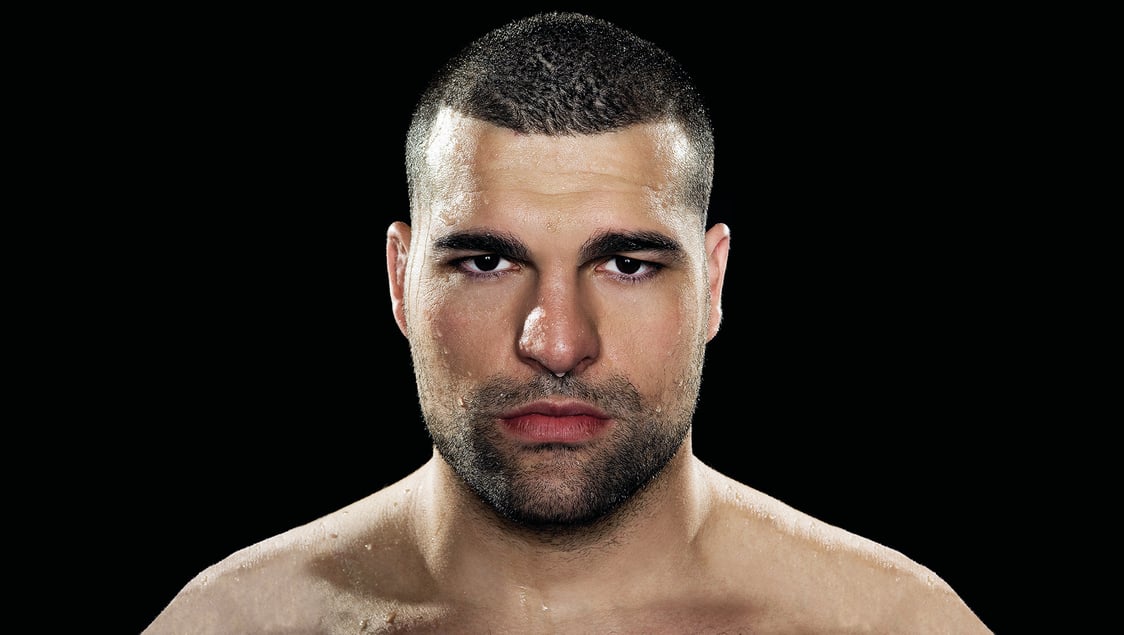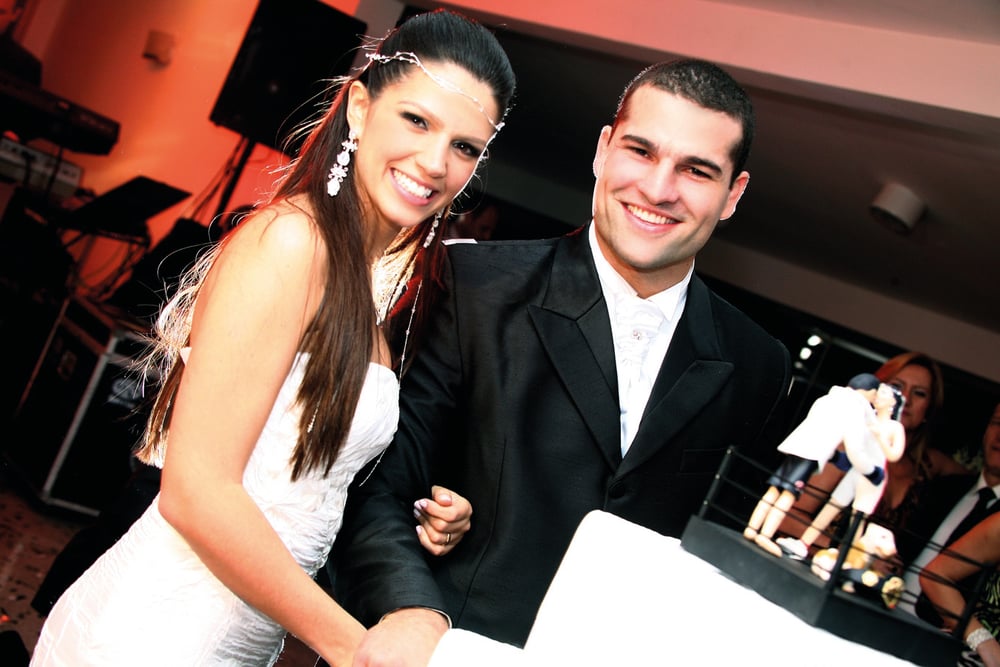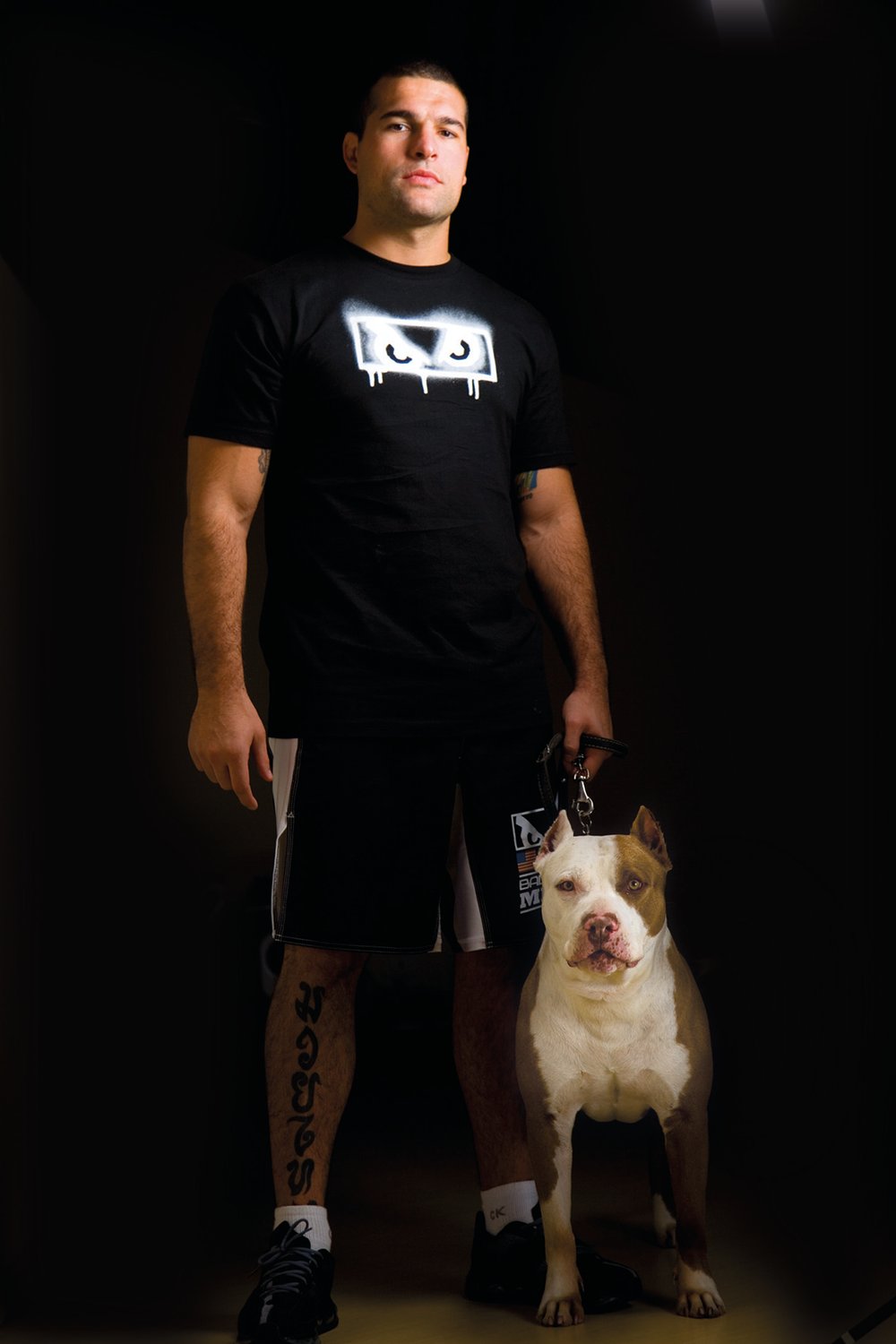
Issue 061
April 2010
After his controversial loss to Lyoto Machida, in October 2009, Mauricio ‘Shogun’ Rua returned home to the city of Curitiba, Brazil in a funk. He thought he had done enough to beat ‘The Dragon’ during their five-round fight, but the judges felt otherwise. It was one of the most controversial decisions in recent years, and called for an immediate rematch. Dana White thought Shogun had won and was left fuming, stating, “Who cares what I think? I'm only the fuckin' promoter!” Such were his feelings about the result, he gave Shogun a backstage bonus that doubled his pay for the fight – it was White’s way of saying sorry, and of showing Shogun he had faith in him. The UFC may not decide the winners, but they do make the fights, and one of the first things White wanted was to see them fight again.
It is the night of August 28, 2005. Mauricio Rua steps into the white canvassed ring for the second time this evening. His opponent is the fearsome Ricardo Arona, a fellow Brazilian fighter. Aside from the tanned skin and tattoos, they couldn’t be more different. Shogun is the high-flying kickboxer whose attacks resemble those of a video game character. Arona is the densely muscled grappler famed for his crushing power.
Two minutes and 54 seconds of fighting have passed, and Shogun’s arm is raised in the air. A joyous smile beams from the face of the 24-year-old fighter. He has just won the Pride FC middleweight Grand Prix, having TKO’d Arona with a series of bludgeoning hammerfists. It is the culmination of a dream year for Shogun, who, in the space of five months, has beaten Rampage Jackson, Antonio 'Minotoro' Nogueira, Alistair Overeem and now Arona. There are no 205lb fighters hotter than him on the planet right now. Wanderlei Silva says Shogun is the only man who truly has the ability to beat Fedor Emelianenko.
Fast forward two years. It is September 22, 2007, and Shogun enters the UFC Octagon for the first time. This is the moment fans have been waiting for – Pride FC's most sought-after light heavyweight is finally here. The man who destroyed Quinton Jackson, who submitted Kevin Randleman, who KO'd Alistair Overeem, is ready to show the world what he has. His opponent is Forrest Griffin, renowned for being a game 6’3” fighter with awkward striking and a willingness to brawl.
Fifteen seconds are left in the round, and Griffin snakes his arm around Shogun’s neck in a classic rear naked choke. The Brazilian has no choice but to tap, ending his dream of entering the UFC with a bang. The fans are shocked – what happened to the fighter they were expecting? Who was this sluggish, out-of-shape brawler, and what happened to the athletic striker they had seen dazzle in highlight reels?
The second coming of 'Shogun'
The Shogun of today is far different to the one who fought against Griffin on that September night two and a half years ago. Since that loss, he stopped the warhorse Mark Coleman and KOd the former champion Chuck Liddell. Of his most recent performances, the showing against 'The Iceman' was probably the one most akin to the Pride FC-era Rua, but Shogun has always fought like that. You only need to go back and look at his early fights for evidence.
Shogun made his MMA debut in 2002, as a 20-year-old kickboxer representing the world-famous Chute Boxe academy. Like his older brother, ‘Ninja’, he made his first foray into MMA on the long-running Brazilian event called Meca 7. Fought under modern vale tudo rules (which were the same as Pride FC's), it allowed kicks and stomps to the head of a downed opponent – trademark attacks of the Chute Boxe Academy, which had already produced fighters such as Wanderlei Silva, Anderson Silva, Pele, and 'Ninja'.
After three straight wins in Meca and an impressive (if unsuccessful) showing in the 2005 IFC tournament – which included Forrest Griffin, Jeremy Horn, Trevor Prangley, and Chael Sonnen (Shogun lost to overall winner Babalu by guillotine) – Rua was introduced to the Japanese audience as the best sparring partner of Wanderlei Silva.
Three years and 12 fights later, and Rua was named by many as the top light heavyweight fighter in the world – though many American fans had no idea who he was. The only light heavyweight they cared about was Chuck Liddell, who was riding a seven-fight win streak. Consider this though: Liddell’s last loss had been in 2003 to Rampage Jackson, whereas Shogun had blown through Rampage in under five minutes.
When Pride FC folded in 2007, Shogun was brought to the UFC as the representative of the once-great Japanese organization. For years, Pride FC fans had been saying their fighters were better than those in the UFC; now it was time to show them just how good they really were. But coming off two serious knee injuries, Shogun was far from his best shape. The loss to Griffin hurt. Rua’s poor showing in his UFC debut (along with the terrible performances of most other fighters drafted in from Pride FC, which later became known as ‘the Pride curse’) made people forget about his amazing career until this point.
But time proved that it was no wonder Wanderlei Silva described Shogun as the only man able to beat Fedor, such were his abilities.
Shogun’s impressive knockout of former UFC champion Chuck Liddell, in April 2009, gave him the right to face the undefeated Lyoto Machida for the title. But even his performance against Liddell wasn’t enough to convince the fans that he could beat the champion, who was undefeated with 15 wins and seven straight wins in the UFC.
The result of the fight was one of the most discussed and debated in UFC history, and the result drew much criticism. Many felt that Shogun won the fight with his constant aggression and ring control, and in particular his strong leg kicks – Machida was left barely able to walk after the fight, and sat and waited for people to leave the post-fight press conference so they would not see him limp away.
The judges decided that the belt should stay with Lyoto, and the result left Shogun revolted. “It was absurd. The audience and even Dana White thought I won, but unfortunately the judges saw a different fight”.
The brothers Rua
Shogun shares more than just a Japanese-themed nickname with his older brother, Murilo (known as ‘Ninja’). They both made their MMA debut at 20 years of age, but Ninja (two years older than Shogun) had racked up eight fights by the time Shogun was ready to compete, including two fights in Pride FC, one of which was a split-decision loss to Dan Henderson.
Their surname, Rua, is often mistaken with that of vale tudo pioneer Marco Ruas, who fought in the UFC during the no-holds-barred era. “The surname came from my father, who was born in Portugal,” says Rua. “My name is Rua and Marco's name is Ruas. I am a big fan and I consider him as one of the pioneers of Brazilian vale tudo. In the past, fighters used to be good on the feet or on the floor. He was the first one to have a great game on the feet and the ground. It motivated me a lot.”
Shogun’s entry into the world of combat came when he began Muay Thai at the age of 15. His older brother was training with a Chute Boxe instructor at the time, and the young Mauricio joined him. When he was 17 years old he moved from his home of Curitiba to Santa Catarina (330km away) to live with his father, and started to train jiu-jitsu.
Rua claims that he and his brother Murilo get their athleticism from their mother. “I guess it’s genetic,” he says with a shrug. “My mother, Clementina, is a professional runner. Two years ago, she was 52 years old and she was ranked 5th in Brazil in her category. My mother is like an idol to me – she is separated from my father, who lives in Blumenau [200km from Curitiba].”
Shogun is actually the second of three boys – his younger brother, Marcos (nicknamed Shaolin), is another physical specimen, but lacks the fire and focus of his siblings. “He is taller and heavier than me and Ninja. He is pretty violent and already made his ring debut, winning a Muay Thai competition, but unfortunately he doesn’t like to train hard. I think he wants to be a DJ.”
The Chute Boxe era
When Shogun started fighting, Curitiba’s Chute Boxe Academy was considered one of the best teams in the world. The team were in their heyday, and boasted members such as Wanderlei, Anderson Silva, Pele and more. Growing up in such an environment meant Shogun had the best ‘education’ possible. “I was a beginner but I had the opportunity to train with Anderson, Pele and all the guys from the ‘third generation’ of Chute Boxe. Anderson always had more talent than the others – his techniques were always above the others. I was 19 or 20 years old, a jiu-jitsu blue belt, not even graduated in Muay Thai, and Anderson was already a black belt.”
Though Shogun shared the gym with Anderson, it was another fighter who took him under his wing. “I've never had a close relationship with him like I had with Wanderlei. That's why I had great memories of Wanderlei and all the Chute Boxe members – I have a special affection for them.”
2007 saw a number of the core members move away from Chute Boxe. Anderson had left under a cloud some years previously, Wanderlei moved to the United States to train in Las Vegas and the Rua brothers followed suit by establishing their own academy called Universidade Da Luta [University of Fighting], though Shogun misses the camaraderie of the old Chute Boxe Academy. “I miss the guys. There were always a bunch of top guys to train with in the academy. Every day of training was really hard.”
One thing that Rua doesn’t miss is the famous ‘gym wars’ that used to take place. The Chute Boxe Academy was notorious for its hard sparring sessions, which Shogun isn’t keen to replicate. “Today we save the athlete more, don't spar that much, because that is what hurts the fighters more. After all, fighting is my job and I want to fight 10 more years.”

The toughest fight of all
“I believe every fight is tough,” says Shogun, “but the fights with Lyoto and Minotoro were the toughest I had.”
Shogun walked away from his tussle with Lyoto relatively unscathed, but was frustrated by Machida’s game plan. His battle with Mark Coleman may have been physically draining, but nothing compares to his 2005 encounter with ‘Minotoro’ Nogueira, the light heavyweight twin brother of former UFC and Pride FC heavyweight champion Minotauro.
Rua won that fight, but it was a tough 20-minute battle that saw him dropped with a shot to the jaw. Minotoro recently signed with the UFC, leading the way for a possible rematch, and Shogun welcomes the chance to fight again. “Fans want that fight again, and I think we're going to meet each other again. Minotoro is a guy I respect a lot and we talk often. Nobody can be underestimated. He is at the top of the category – he has proved that. I'm sure that fight will happen soon.”
Rua is not one to choose his fights, and would happily face Machida, Minotoro or Anderson Silva. “Of course, I can fight those three guys; I'm a professional. I've never chosen my opponents in my entire life,” he says. “Wanderlei and my brother are the only ones who I would never fight.”
Facing 'The Dragon'
Rua’s first fight with Machida will go down in history, but for the wrong reasons. Arguments still rage as to who should have been declared the rightful winner, and Shogun is annoyed with himself that he didn’t try to seal a victory. “I needed to attack him more intensely in the last round. My corner said I was winning, so I thought; ‘I'm winning the fight, I won't expose myself.’ I thought I was winning, so I didn’t want to expose myself too much, because Lyoto is a guy that uses counterattacks.” He has had plenty of time to think about what he would do differently, but planning for an opponent as elusive as Machida is difficult. “It's hard to know what I would do. I tried to get the fight to the ground, but he has good balance, so I didn't waste my energy because I felt comfortable striking,” he says. “I was calm, trained hard, I was prepared and I managed the five rounds, so I'm going to sit with my team to analyze everything. Everything comes at the right time, and when that moment comes, we'll think about it.”
Preparing for someone of Machida’s caliber is no easy task. The Brazilian-Japanese fighter is known for his unorthodox and adaptive style, which makes training for him particularly troublesome. “Lyoto is different to other athletes. Against any other fighter, you go to the academy, practice and go home naturally. Against him, I had to take a different approach, because his style is different from others. He fights at long distance or at short distance, not the medium distances, where I like to work on. Against any fighter, I would do everything on a regular basis, but Lyoto is different.
“We recruited some karatekas from Curitiba, who helped me a lot. I have Dida, Marcelinho and Tuba to help me with the tactical stuff. Marcelinho watched Lyoto's fights like 15 times. We joked that he became Lyoto.”
What can Shogun expect in a second fight with the light heavyweight champion? “Another battle and another Lyoto,” he says. “Everything is new: the focus, the strategy – here we go. It's my big dream. I'll concentrate and go and fight with even more desire. I'll be even hungrier this time – to conquer a UFC belt has always been my dream.”
A model fighter
Shogun is frequently named as a ‘ladies' choice’, and his good looks have earned him more than just the adoration of the female fans. Believe it or not, Rua worked as a male model during much of his fighting career. “It happened right after Storm Muay Thai [in 2003]. I was in a small flea-market and there were three ladies and a gay guy looking at me. I thought that scene was very strange, and one of the ladies called me and started to chat with me.
“She invited to me to a ‘book session’ [sample photos], for free, and I started to work as a model. Until a few years ago, I kept working as model, and I have been to several events, but today I’m 100% a professional fighter.” Modeling may seem easy compared to fighting, but Shogun says it’s actually tougher than stepping in the ring! “Being a model seems easy, but is very stressful… My real passion is fighting, and that’s my only goal in life.”
Life away from the ring
What are your hobbies besides fighting?
Besides training I like to play soccer – at least I try! [Laughs.] I like to watch movies at the cinema, and I go out to walk with my dog, Chakal, every day. As you can see, I have a pretty common life.
People used to say that dogs resemble their owners, but this is the nicest pit bull I’ve ever seen!
I believe that if you are a violent person your dog may absorb that and also be violent. Chakal is a good example of that. He is a pit bull but behaves like a poodle, treating everybody very well, just like me and my brothers.
Tell us how you met your wife.
We’ve been together for four years. We met for the first time in a very funny situation. I was walking with my dog, close to my house, and she was lost in Curitiba and asked me where the shopping mall was. I thought, “What a cute girl,” and started to talk to her and asked her cell number. She gave it to me, and by that night I had called her, picked her up and we started to date. Her name is Renata Ribeiro, and she is a personal trainer.
What did she say when you told her you were an MMA fighter?
It was very funny. The first time she came to my house, one week after we first met, she saw a lot of trophies in my room and asked what my profession was. I said I was an Axé dancer [Axé is a typical rhythm from Bahia that looks very much like samba], and she believed that for a long time! [Laughs.]














